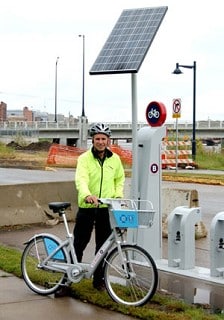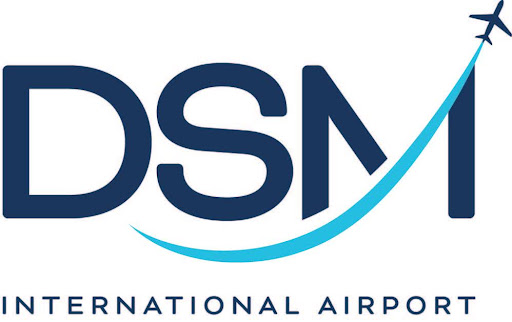Downtown public transit could see transformation

Public transportation in Des Moines is poised to receive a facelift.
Three projects could make Des Moines a very different city to maneuver by way of train, bus or bicycle, and all three seem to coincide with each other.
One of those projects is already a reality, another seems certain, and the third is in its infant stages.
Des Moines’ B-Cycle program was launched last month. The program allows bikers to check bicycles in and out at various downtown locations.
The second could be ready as early as 2012, pending funding. The Des Moines Area Regional Transit Authority (DART) has begun the process of building a new $22 million transit hub.
The third, a proposed passenger rail station connecting Des Moines to a route from Chicago to Omaha, could be a reality in six or seven years, pending a state study to determine whether Des Moines will be on the route.
Together, these projects could form an unofficial downtown public transit campus between Fourth Street and Seventh Street on the east and west and Cherry Street and Martin Luther King Jr. Parkway on the north and south. Railroad passengers could easily catch a bus to or from the train station and bus riders could check out a bike to complete their downtown journey.
B-Cycle program pedals on
Des Moines recently became only the fifth U.S. city to implement a downtown bike rental program.
The concept is simple: Check out a bike from a kiosk, ride it to the kiosk closest to your next destination and check it back in.
“The target user is someone who wants to go on trips that are one to three miles,” said Carl Voss, chair of the nonprofit Des Moines Bicycle Collective, which owns and operates the program.
“It’s not a Hy-Vee Triathlon bike. Do an errand, have lunch, meet someone for a business meeting.”
The program was modeled on two cities that already have a similar program ¬¬– Denver and Minneapolis. The goal is to give people an opportunity to move around within the city for distances that are too far to walk, but not far enough to drive.
“In Minneapolis and in Denver, the big users there are people who are using this for their first and their last mile of their commute, so they’re using it in combination with public transportation,” Voss said.
Right now, B-Cycle is a pilot program, which means it’s in a testing stage. Four kiosks are set up around the city, including Principal Park, Brenton Skating Plaza, the intersection of Seventh Street and Grand Avenue and the intersection of 13th Street and Grand Avenue. The program currently has 18 bicycles.
That’s a good starting point, but it’s not enough, Voss said. He hopes to add more bikes and triple the amount of stops in the next couple years, the most important one being next to DART’s current transit hub on Walnut Street. In addition, DART has planned a space for kiosks at its new hub.
The program provides a lot of advantages to downtown Des Moines, Voss said. Riding bikes on short trips can help cut down on pollution and provide a form of exercise. It gives out-of-town business travelers and tourists a way to navigate downtown without needing a car, and it eliminates parking worries.
And it gives Des Moines a buzz factor.
“People notice the bikes on the street. They’re different,” Voss said. “People see them and say ‘This is a bike-friendly city. I can get out on my bike and go places.’”
Since starting its $120,000 pilot program on Sept. 1, B-Cycle has gained 129 members as of last week. Though most have just purchased a 24-hour pass, 20 people have signed up for an annual membership. An annual membership is $50, a 30-day membership is $30 and 24-hour pass is $5.
A number of local businesses have helped fund the program, and Voss hopes that when the fleet reaches around 500 bicycles, the program will sustain itself.
As only the fifth city to implement such a program – behind Denver, Minneapolis, Chicago and Washington, D.C. – Des Moines has become a trendsetter. Similar programs are on the verge of popping up in other cities, including Seattle, San Antonio and Omaha.
“I do appreciate the vision of the Des Moines leaders who bought into this,” Voss said. “Instead of waiting to see how it worked in Omaha, we’re ahead of Omaha.”
DART set to make hub a reality
With half of the funds secure, DART is scheduled to start work on its new facility early in 2011.
DART officials saw a number of reasons to build a new hub, which will be located south of Cherry Street between Sixth Avenue and Seventh Street.
The current Walnut Street Transit Mall hinders customer service and provides safety hazards, said Elizabeth Presutti, chief development officer. The Walnut Street location has a first-in, first-out configuration, and waiting passengers don’t know exactly when their bus will get in and where it will be compared to other buses.
“The passengers are always having to scurry about and find what bus they are going to connect to,” Presutti said.
The new facility will ease that problem, as buses will stop in the same location within the facility every time.
Riders will also be able to see where their bus is located and the estimated time of arrival via global positioning system (GPS) units DART will install in the buses.
In addition, DART’s main offices will be moved from the current location south of Martin Luther King Jr. Parkway.
“Most of our customers come into downtown, so we really just want to be closer and have better access,” Presutti said. “Most people have no idea where we are located in town, so we’re just trying to really provide a higher level of customer service.”
DART wants the new facility to be high on amenities, including climate-controlled spaces to wait for the bus, a customer-service center and a bike storage area.
The facility comes with a $22 million price tag. DART has secured $4 million through the state’s I-JOBS program and another $6.5 million from the federal transit administration, leaving $10.5 million to raise. Presutti said DART has applied for the remaining money in a pair of grants; a decision on that money is expected this fall.
For now, DART has split the project into two phases. Phase one includes the building and site prep work around the building, and phase two will consist of building the bus platforms and canopies.
Presutti said it made more sense from a safety and construction standpoint to build the building first so it will be usable while the transit area is being built. The new central offices will be in place before buses are able to stop in the facility.
The design and ideas for the new hub were modeled after what other cities had done, specifically Grand Rapids, Mich. Several DART employees took a trip to see the hub of the city’s bus system, The Rapid.
Grand Rapids was the first LEED-certified bus transit hub, as measured by the U.S. Green Building Council, and DART is aiming for LEED gold certification, the second-highest level.
“It’ll be a really neat educational facility with all the technology that’s in it,” Presutti said.
Rail station next?
The Iowa Department of Transportation (DOT) is on the verge of beginning a study to determine whether Des Moines will be a stop on the proposed passenger rail line from Chicago to Omaha. Des Moines is on one of five routes in the study.
Amanda Martin, freight and passenger policy coordinator in the office of rail transportation in the Iowa DOT, said though the DOT would have to exhaust all options for the study before making any decision, Des Moines does look like an attractive option.
“There’s a lot of reasons why it makes sense to go through Des Moines because of population, and it meets the purpose and need (of the project).” Martin said.
The Des Moines Area Metropolitan Planning Organization (MPO) released a feasibility study earlier this month of six different possible locations for a station along the train tracks that run through downtown just north of Martin Luther King Jr. Parkway, if service goes through the area. Five of the locations were downtown and the sixth was at Valley Junction in West Des Moines.
The site determined to be most feasible is the location of the former Chicago, Rock Island and Pacific Railroad Depot at 100 Fourth St., which currently holds the offices of Business Publications LLC. The building is only a block away from where the DART transit hub will be located.
The study cited the building’s proximity to the bus transit hub and the fact that it is an existing facility already in use as reasons why the location makes the most sense.
“This site includes an existing structure that, historically, was the primary passenger rail depot for the Des Moines metropolitan area,” the study said.
The building is for sale by the current owners, Rock Island Depot Partners; Business Publications chairperson Connie Wimer holds 99 percent of the stock. Wimer said not only would she consider selling the building for that purpose, but thought it would be an ideal situation for the building to again become a rail depot.
The next best site, according to the MPO study, would be in Lower East Village between East First Street and East Third Street, the study said. That site is about a half-mile east of the DART transit hub, with no pedestrian connection, though a bus line and bicycle route are planned within a few blocks of the site.
Other downtown options the study considered less feasible included the former East Side Union Rail Depot at 120 E. Fifth St., an underdeveloped site at the intersection of 10th Street and Cherry Street and the site of the future DART transit hub itself, which the study concluded to be too small for two facilities.
Though the city’s passenger rail hopes are uncertain, Des Moines is taking the steps to ready itself for service. If the route that includes Des Moines is chosen, the next step would be determining how much funding is needed for infrastructure purposes and where the funding will come from, whether from a federal funding grant or state and local funds, Martin said. Funding will go a long way toward determining the time frame, and the best case scenario would be for passenger service to reach Des Moines in six years.
“Obviously the folks in Des Moines are very interested in trying to get something moving forward, so we just would need to lay all the information out and see what the next step is,” Martin said.











